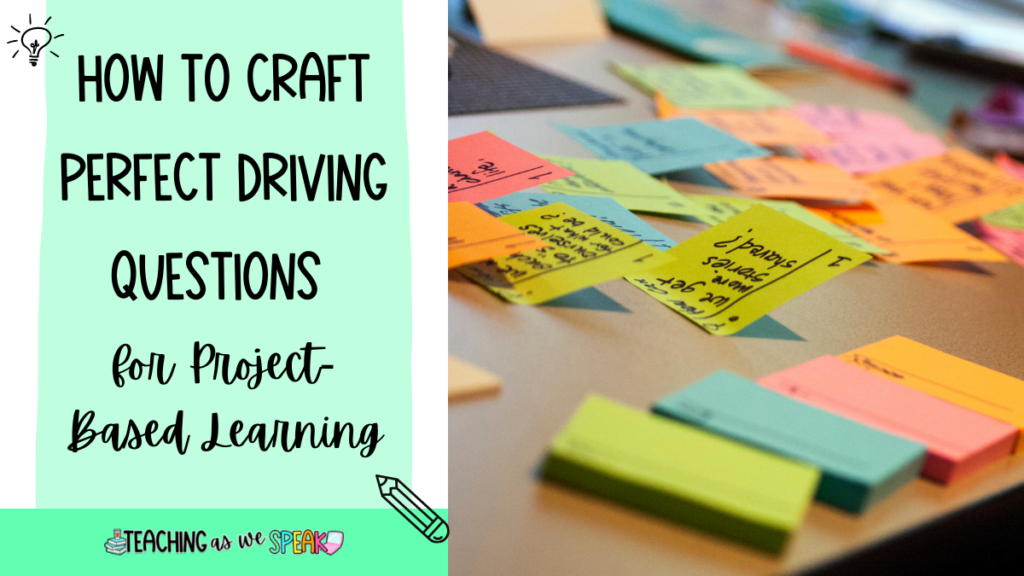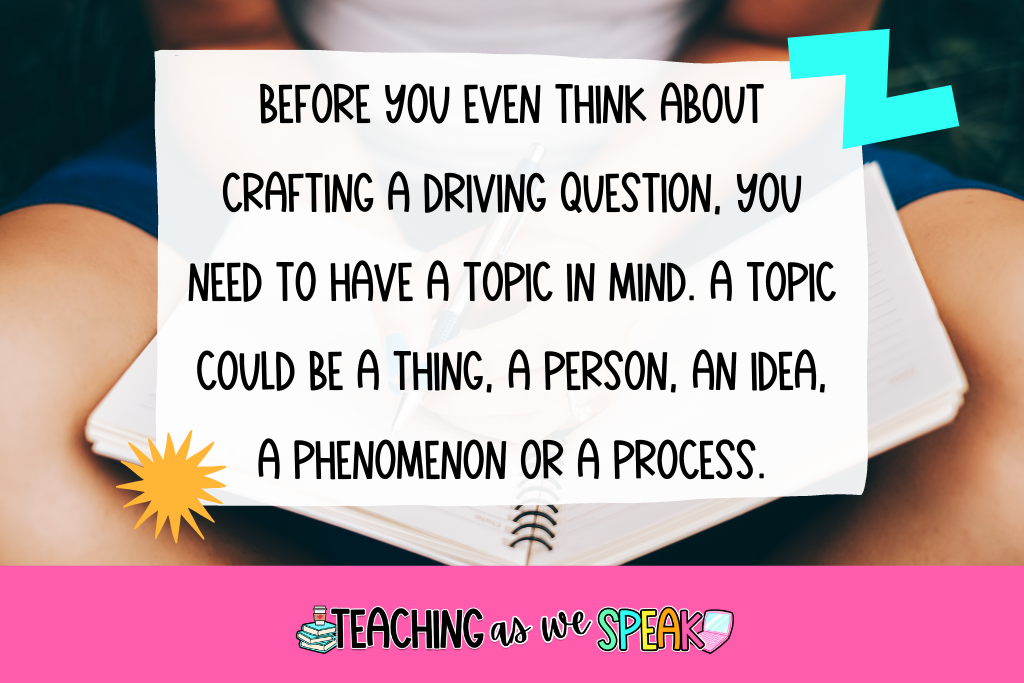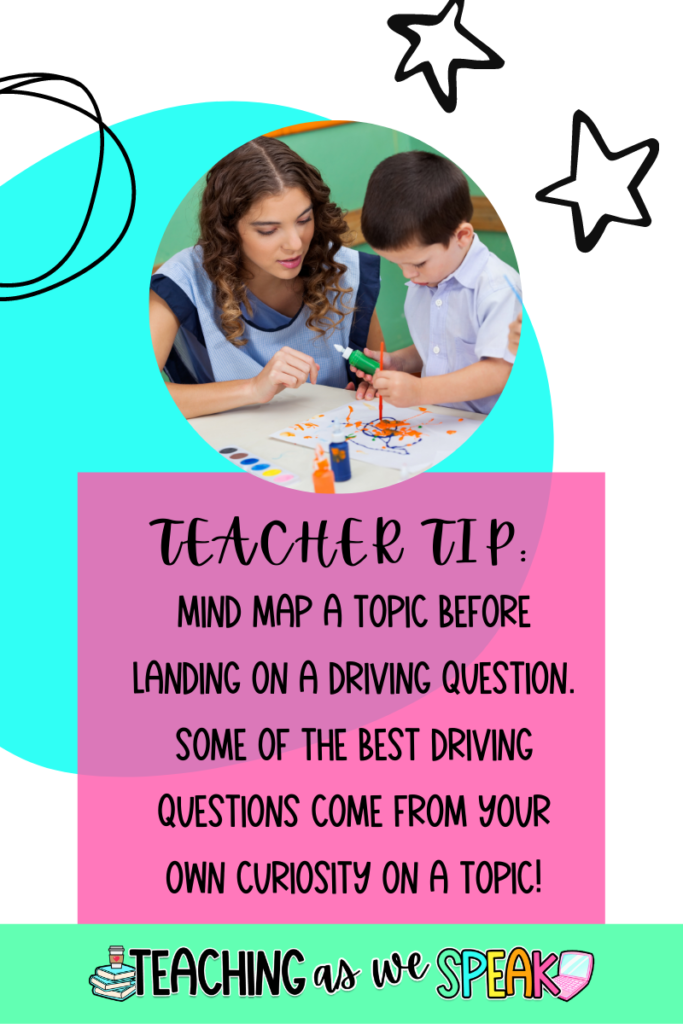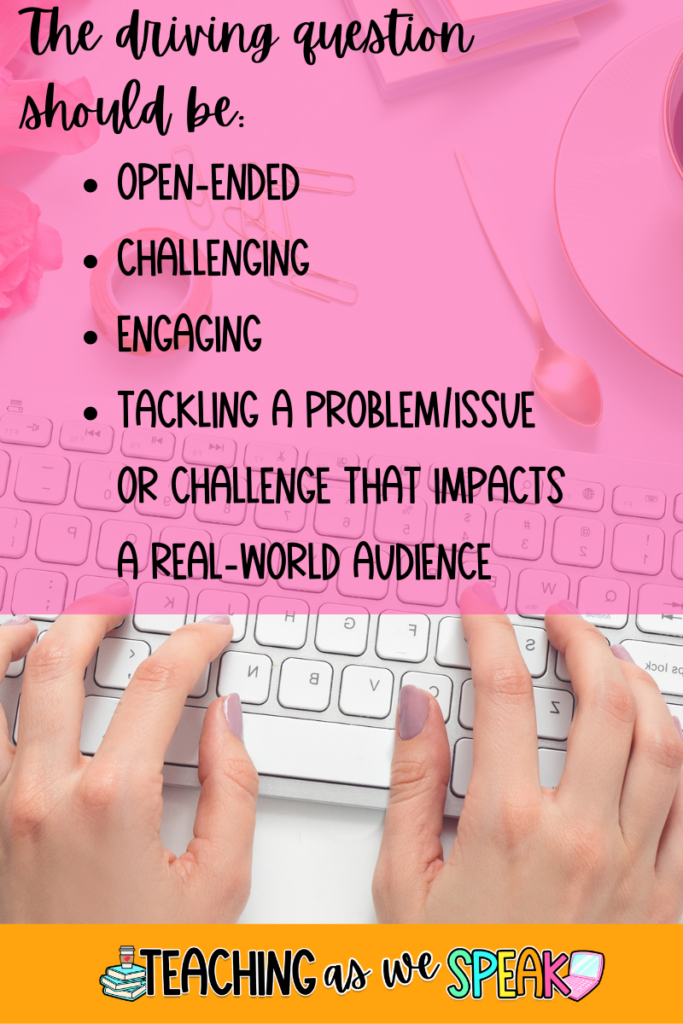It is a skill to know how to craft perfect driving questions for project-based learning. A skill, more often than not, that gets overlooked. When planning, teachers often skip over the nitty-gritty details such as defining the topic and driving question.
Why is that?
It’s because teachers know what they want a project to look like, and figure the topic and driving questions is simply semantics.
However, the truth is, it’s an art form to craft perfect driving questions for project-based learning. Luckily for you, I’m going to show you how to become an artist!

Step 1-The Step Before the Driving Question
Before you even think about crafting a driving question, you need to have a topic in mind. To clarify, a topic could be a thing, a person, an idea, a phenomenon or a process. A topic is usually the first thing that comes to mind when planning a project or unit for your students.
Here are a few examples:
- The Great Depression-era
- Podcasts
- Greta Thunberg
- Reality-TV
- Fidget Toys
- Coffee Shops
Notice how these topics are pretty broad. That’s ok! Eventually, we will narrow our ideas down later. How do you find these ideas? I find these topics come up in everyday life. It could be when I’m walking the dog, or listening to my students having a conversation. My ear is always open to new project topics.

One of the best and easiest ways to come up with ideas is to hold regular conversations with your students. I do this through the use of discussion task cards. Check them out here! I will pay close attention to the topics that come up through these discussions. I suggest writing these recurring topics in a notebook somewhere.
Check out my recent blog post about unit topics and where to find inspiration.
Once you have listed these topic ideas, choose one! You can play with the other ones later in a future project!
Step 2 to Crafting Perfect Driving Questions for Project-Based Learning: Mind Map
This is hands-down my favourite part! It wouldn’t be a teacher blog if we didn’t mention mind mapping somewhere!
After choosing your topic, it’s time to get mapping! I want you to write down every related thought or idea that comes to mind when you think about this topic. And I mean, every idea. This is not the time to be selective!
This can be done in a map format or by listing every idea.
Some of your ideas may be questions. That’s ok! Just write everything that comes to mind down on paper.
Here are some examples of related ideas for the topic of podcasts:
- What was the first podcast
- Radio vs podcasting
- Most successful podcast
- Is radio a dying industry because of podcasts?
- Which demographic listens to podcasts most?
- How do you make a podcast?
- Can you make a lot of money from podcasting?
- What about deaf or hard-of-hearing people? Is there an alternative?
Notice how I started by writing topics down and then transitioned into questions. This was not intentional! I just naturally gravitated to topics I could easily research, and let my curiosity take me to questions I perhaps don’t know the answer to.
Hint: some of the best driving questions for students will come from your own curiosity!
Now, your instinct may be to land on one of the questions you wrote down during this step. However, I want you to stay with me! It’s happened to me that I have done a mind map, asked myself a question and then stopped there. The issue is, this may be a question I am interested in learning about, but may not be what my students were excited about.

Step 3- Categorize your ideas
After completing your mind map, You should have a page full of ideas of questions. Now, try to group common ideas together. Look for common themes or trends in the ideas you listed.
Next, categorize these topics into related topics. Here’s an example I could use for the podcast example:
- Podcast vs Radio
- Podcast trends
- The founding fathers of podcasts
- Making a podcast
- Accessibility
Step 4-Think About Your Students!
So far, we’ve focused on your thinking. Now, it’s time to move away from your thoughts and opinions and think about your students. Now, take a good/hard look at the categories that you’ve created and ask yourself, “Which one would be students be most excited about?”
Then, choose one sub-topic that you feel would interest your students the most. Remember, project-based learning ideas for elementary students need to be highly engaging!

Want more help with project-based learning? Click here to download the Beginner’s Guide to Project-Based Learning for Elementary ELA teachers. It includes a free two-week project that will have students answering the question, “how do you know if you have a growth mindset?”.
Step 5-Craft the Perfect Driving Question
Now, it’s time to craft your driving question. The question should be:
- Open-ended
- Challenging
- Engaging
- Tackle a problem/issue or challenge that impacts a real-world audience
To help you get started, I suggest starting your driving question with ‘what’, ‘why’, ‘how’ or ‘when’.
Here are some examples of driving questions for project-based learning:
- “How are podcasts made accessible to all people?”
- “How are podcasts affecting our society’s access to information?”
- “Why do people make podcasts?”

Always remember, these questions will be driving your students’ learning. Ultimately, students will be creating a project as they learn.
Click here to read my recent blog post about Driving Questions for PBL.
Final Thoughts on Driving Questions for Project-Based Learning
If you’ve made it through all 5 steps, congratulations! Hopefully, you were taking action as you read through each step and have crafted the perfect guiding question for your next PBL project!
Do you have any questions? Comment down below and I’ll get back to you ASAP!





2 thoughts on “How to Craft Perfect Driving Questions for Project-Based Learning”